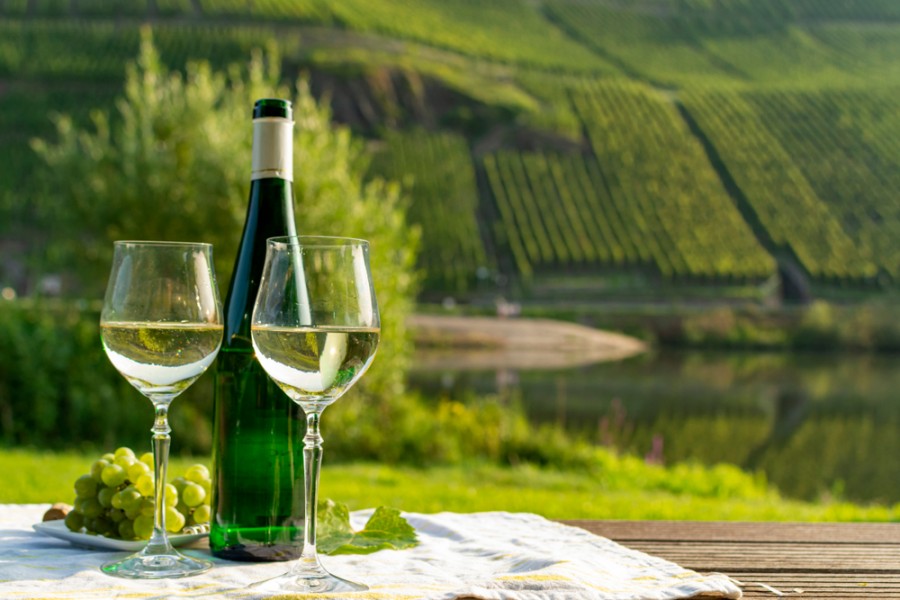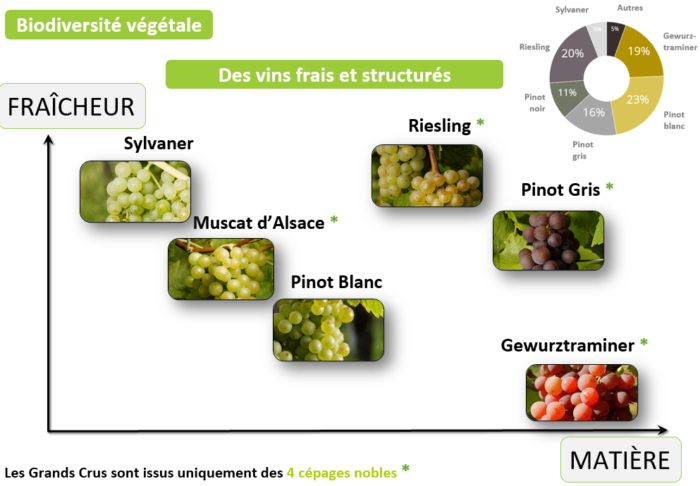Alsace wines occupy a unique place in the French wine landscape. Renowned for their freshness, elegance and diversity, these wines seduce with their aromatic richness and gastronomic versatility. Thanks to Alsatian grape varieties, each bottle tells its own story, inspired by the terroir and know-how of its winemakers.
An exceptional terroir for unique wines

Located in eastern France, between the Vosges and Rhine rivers, Alsace boasts an exceptional terroir.
- Varied soils: Limestone, sandstone, clay and schist bring distinct nuances to the wines.
- Sunny climate: Warm, dry summers favor optimal grape ripening.
- Natural protection: The Vosges mountains protect the vines from excessive wind and rain.
These conditions allow Alsace's grape varieties to express themselves fully, producing quality wines with unique aromatic profiles.
Alsace's emblematic grape varieties

1. Riesling
Riesling is often considered the king of Alsace grapes.
- Caractéristiques: Dry, lively, with notes of citrus, peach and minerality.
- Ideal with: Seafood, grilled fish, sauerkraut.
- Style: This aromatic wine is appreciated for its freshness and ageing potential.
2. Gewurztraminer
Gewurztraminer seduces with its expressive character and captivating aromas.
- Caractéristiques: Notes of lychee, rose, spices and honey.
- Ideal with: Strong cheeses, spicy dishes, fruity desserts.
- Style: Rich, unctuous and often slightly sweet.
3. Pinot Gris
Pinot Gris is known for its versatility and roundness on the palate.
- Caractéristiques: Aromas of yellow fruit, honey, and sometimes a slight smokiness.
- Goes well with: Poultry, foie gras, dishes in sauce.
- Style: This variety produces complex, generous wines.
4. Sylvaner
Sylvaner is often underestimated, but offers fresh, accessible wines.
- Caractéristiques: Fresh, light, with notes of apple and herbs.
- Ideal with: Salads, seafood, simple dishes.
- Style: Ideal for everyday consumption.
5. Muscat
Muscat d'Alsace is appreciated for its aromatic expression of fresh grapes.
- Caractéristiques: Notes of fresh grapes, white flowers and fruit.
- Ideal with: Asparagus, light aperitifs.
- Style: This aromatic wine is perfect for convivial occasions.
Alsace white wine styles
1. Dry wines
Most Alsace wines are dry, offering great freshness and culinary versatility.
2. Sweet and syrupy wines
Late harvests and noble grapes produce sweet wines of great aromatic richness.
3. Crémants d'Alsace
Crémants, made using the traditional method, add a festive touch with elegant, fine bubbles.
Why choose Alsace white wines?
1. Exceptional aromatic diversity
Alsatian grape varieties allow for a wide variety of styles and taste profiles, suitable for all occasions.
2. Consistent quality
Alsatian winemakers are renowned for their rigor and expertise, guaranteeing wines of the highest quality.
3. Sublime gastronomy
Thanks to their freshness and complexity, Alsace white wines go well with a multitude of dishes, from the simplest to the most elaborate.
Perfect food pairings with Alsace white wines
1. Seafood and fish
A dry Riesling sublimates oysters, grilled salmon or scallops.
2. Spicy dishes
A Gewurztraminer goes perfectly with Thai, Indian or Moroccan dishes.
3. Cheeses
Gewurztraminer is ideal with Munster cheese, while Riesling goes well with Comté.
4. Desserts
Late harvest or noble grape varieties are ideal for fruit tarts, crème brûlées or sorbets.
Explore Alsace wines through their appellations
1. AOC Alsace
Covering a wide range of wines, this appellation guarantees origin and quality.
2. AOC Alsace Grand Cru
Grands Crus represent excellence with wines from exceptional terroirs.
3. AOC Crémant d'Alsace
This appellation offers refined effervescents, perfect for celebrations.
Current trends in Alsace wines
1. Biodynamic viticulture
More and more estates are adopting biodynamic practices, favoring wines that are more authentic and respectful of the environment.
2. Natural wines
Wine lovers are looking for wines produced with a minimum of intervention, fully reflecting the terroir.
3. Back to little-known grape varieties
Forgotten grape varieties such as Klevener de Heiligenstein are regaining popularity, enriching the Alsatian offering.
Tips for choosing and tasting Alsace white wines
1. Focus on local producers
Smaller estates often offer treasures to discover, with excellent value for money.
2. Match the wine to the dish
A dry Riesling goes well with light dishes, while a rich Gewurztraminer is perfect for more robust dishes.
3. Observe operating temperature
Serve Alsace white wines between 8 and 10°C to fully appreciate their aromas.
4. Experimenting with chords
Don't hesitate to try out bold combinations to discover new harmonies of taste.
Conclusion: a region to discover for white wine lovers
Alsace wines embody the perfect blend of tradition, diversity and innovation. Thanks to Alsatian grape varieties and an exceptional terroir, they offer a unique taste experience for every occasion. Whether you're looking for an aromatic wine for a meal or a Grand Cru for a celebration, Alsace has it all.
If you enjoyed this article, you may also be interested in "Understanding tannins: their role in wine taste"!





